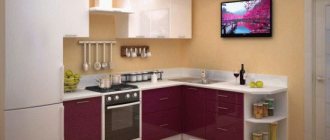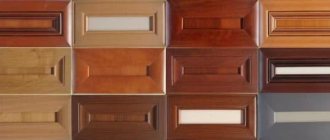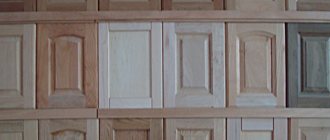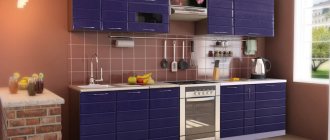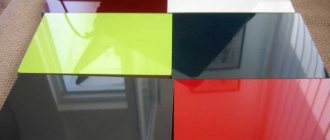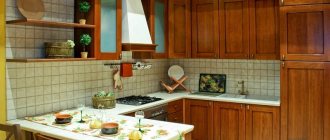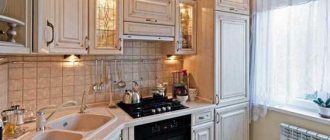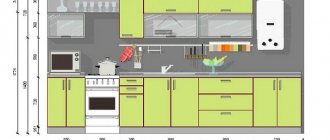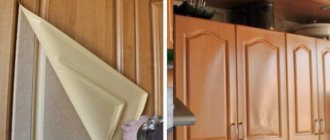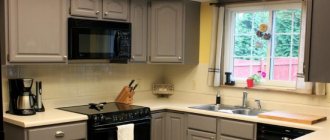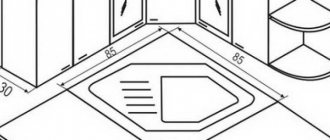The façade of a kitchen unit is its front side. As a rule, the facade is represented by the doors of the elements included in the furniture composition.
It is the front panels of the set that are responsible for the appearance of the kitchen interior. They must be not only aesthetic, but also resistant to aggressive influences - high temperatures, sunlight, moisture, splashes of oil and fat. Only in this case will the furniture be able to retain its original appearance for a long time and delight the owners of the house for many years.
How the kitchen façade works - what is it?
The façade of the kitchen furniture consists of two parts:
- basics;
- decorative covering.
The basis of the facade is a slab made of durable material, which determines the basic operational properties of the structure.
And the decorative coating is responsible for the appearance of the furniture and at the same time serves to protect the base of the slab from exposure to high temperatures and moisture. It is a thin layer of highly durable and aesthetic material.
Manufacturing materials and coatings
The quality, susceptibility to various external factors and cost depend on the material from which the furniture façade is made. You can choose from several options:
- laminated chipboard;
- MDF;
- solid wood;
- glass;
- metal.
Chipboard is the most affordable, but least practical material of all listed. Its strength can be increased through special protective coatings. Contains formaldehyde resins, which negatively affect human health. Suitable for the manufacture of products of geometric shapes, never used for the production of furniture with radius facades.
MDF is a safer material that also has a long service life. Its price is in the middle category, which, against the backdrop of excellent qualities, is another advantage. The only disadvantage is considered to be high susceptibility to temperature changes and mechanical damage.
MDF facades are found in all types of furniture, painted products are used, as well as in PVC film or plastic. The first option is the most expensive, as it involves manual labor. An undoubted advantage is the unlimited color range and the ability to use special effects. PVC film is much cheaper, can be matte, glossy, or allows you to imitate wood. In this case, additional processing is possible to obtain patinated furniture facades. The choice of plastic coatings is also huge: from bright colors to imitation of natural materials. Unlike film, they increase the strength of the product, since their thickness reaches 2 mm.
On MDF facades, enamel is applied in several layers - the more layers there are, the better the quality of the finished product.
Wooden facades are considered the most expensive, furniture from which has significant weight, deforms under high humidity, and requires special care. But any shortcomings seem insignificant against the background of such advantages: environmental safety, luxurious appearance, maintainability, high strength, durability. Carved facades are made from wood for the kitchen, living room, bedroom, and hallway.
How to decoupage an old cabinet, an overview of popular techniques
Glass facades are made from hardened alloy or triplex. They can effectively complement any interior; they can be straight or curved. They are heavy, which requires additional reinforcement of the frame. They have an almost unlimited service life, but if damaged they cannot be repaired. The choice of glass facades for furniture in the kitchen or living room is large, the material is presented in a wide range of colors.
In modern interiors of bedrooms, hallways, and living rooms, new metal facades are often found. Manufacturers give preference to stainless steel and aluminum. They not only have an attractive appearance, but are also much stronger than wooden ones and are not afraid of mold or mildew. In addition, the aluminum profile does not lose color over time, so the service life of such products has no clear limits.
For those who cannot spend money on wooden facades, but prefer natural materials, chipboard or MDF lined with veneer would be an excellent solution. The latter is a thin layer of wood obtained by sawing, planing or peeling logs. Such products are less capricious to use. Facades with 3D milling, the surface of which imitates the texture of wood, waves, flames, and sand dunes, are also becoming increasingly popular. And when using modern photo printing on furniture facades, you can decorate your wardrobe with any image, even your own portrait.
Laminated chipboard
MDF
Solid wood
Glass
Metal
Types of kitchen facades
Modern furniture manufacturers offer the following types of kitchen facades:
- frame;
- whole.
Frame fronts for kitchen cabinets
Frame facades are structures in the form of a combination of two materials, one of which makes up the middle of the canvas, and the other is its frame.
Sometimes the same material is used, and the frame structure of the product is determined by design features. But most often, facades are made from different materials, and more expensive options are used for the frame.
Framing can be:
- wooden;
- aluminum;
- from chipboard;
- from MDF.
Frame facades have the following advantages:
- affordable cost;
- possibility of manufacturing products of non-standard sizes;
- the combination of two materials within one design gives a wide scope for design imagination and allows you to bring to life the most daring interior solutions.
Such designs also have disadvantages:
- presence of seams;
- difficulty washing;
- reduced wear resistance.
Solid kitchen fronts
The solid facade of the kitchen cabinet is more practical and is a slab without seams or joints. It is characterized by increased strength, is not afraid of moisture and does not deform at high temperatures.
The only disadvantage of solid facades is the high cost.
The basis for the kitchen facade - what is it made from?
The basis of kitchen facades can be made of different materials:
- natural wood;
- MDF;
- Chipboard.
Solid wood products have long been recognized as timeless classics. They will last a long time and will never go out of style. Modern wooden facades undergo special treatment, which allows preserving the unique natural pattern of the material and at the same time protecting it from moisture, hot steam and fading. The main disadvantage of wooden panels is their high cost.
MDF (medium density fiberboard) is a material consisting of fine wood chips glued together under high pressure using natural resins.
MDF facades are environmentally friendly, strong and durable - perhaps this is the best combination of affordable price and high quality.
Chipboard (chipboard) is similar in composition to MDF, but they use synthetic resins, making the material cheaper but of lower quality.
If you want to save money and purchase a set with front panels made of chipboard, pay attention to its top covering - it should be as reliable as possible. Otherwise, if the integrity of the cladding is damaged, the chipboard façade will quickly lose its shape. In addition, there is a risk of evaporation of vapors hazardous to human health.
Typical dimensions of kitchen fronts are;
- 716 (713) ×296 mm;
- 716 (713) ×396 mm;
- 716× (713) x 496 mm.
There are products in non-standard sizes, but they also have limitations. So, the facade should be no more than 2520x920 mm, but not less than 110x596 mm.
Types of coatings for kitchen facades
To give the facade an attractive look, furniture manufacturers use various coatings:
- enamel (paints, varnishes);
- plastic;
- PVC;
- veneer.
Enameled kitchen cabinet fronts
Enamel kitchen facades are products coated with special compounds: varnishes or paints.
Their advantages include:
- a wide selection of colors and effects - metallic, mother-of-pearl, gold, silver and even chameleon. Matte finishes are also available;
- enamel-coated panels are not deformable and can easily withstand moisture and high temperatures;
- Easy to clean - they can be cleaned with any non-abrasive detergents.
The disadvantage of all enamel coatings is their tendency to chip when impacted.
Plastic coating for kitchen facades
Facades covered with plastic are panels made of chipboard or MDF, to which a thin layer of plastic is attached using a special contact adhesive. This solution is rightfully considered the most practical:
- plastic does not scratch, wear off or fade over time;
- it is not afraid of the effects of chemical abrasives and is easy to care for;
- facades with such a coating do not fade for a long time.
If you want the product to last longer and not deform, give preference to models with an additional layer of compensation plastic - it prevents the facade from bending.
Kitchen facades covered with PVC film
PVC (polyvinyl chloride) is a thermoplastic material used to cover furniture facades. As a rule, PVC is used for MDF boards - it is heated and pressed tightly to the facade using special equipment. The result is a facing layer with a thickness of 0.25 to 0.5 mm.
PVC gives the product:
- resistance to mechanical stress - scratches, abrasion and shock;
- resistance to high temperatures and moisture;
- immunity to ultraviolet rays.
In addition, PVC film is much more affordable than other facing materials.
Kitchen cabinet front finished with veneer
Veneer is a layer of natural solid wood no more than 5 mm thick. The advantages of veneered facades are:
- high strength - products do not melt even when exposed to critical temperatures;
- the ability to give furniture a noble look without compromising the budget - the appearance and feel of veneered front panels are indistinguishable from expensive solid wood products;
- If the coating is damaged, you can restore the deformed area without changing the entire cladding.
The only thing in which veneer is inferior to other materials is its high price - plastic, enamel or PVC will cost less.
Types of kitchen facades
In the kitchen, of the entire range of furniture facades, the most actively used are the varieties that simultaneously meet all the listed requirements. Each of these types of facades has its own characteristics, which is why when choosing any option you should carefully study the specifics of its application.
Photo: Kitchen with solid wood facades in a classic style
Solid wood facades
Wooden facades are most often chosen to decorate classic kitchens, because it is in this style that the wood texture looks as organic as possible. Modern trends make it possible to use not only solid wood, but also veneered facades to design various styles: from Baroque to Art Nouveau.
There are two types of wooden facades:
- Solid , that is, made from solid wood. They are expensive and require careful use. To protect against inevitable cracks and deformations, special coatings and protective materials are used, however, they do not guarantee integrity in a kitchen environment.
- paneled facades resembles a sandwich made of two layers of wood and a filling made of veneered chipboard or MDF. This combination of materials not only guarantees an increase in service life, but also makes it possible to significantly reduce the cost of the material and make it accessible.
Environmentally friendly and safe for humans, wooden facades themselves become a real decoration of the kitchen interior, and with proper care and careful choice of style, such a kitchen will not lose its relevance for decades. But, despite the many advantages of solid wood facades, they have certain disadvantages: these are special maintenance requirements (for example, a ban on the use of abrasives and hard sponges), and certain restrictions on creating complex radius or concave shapes.
Photo: Set with red painted facades
Enameled MDF facades
Of modern materials, MDF with enamel coating is the most in demand and popular. This option allows you to make the kitchen not only functional, but also bright, since the range of colors for covering is quite wide. In addition to a huge selection of colors, such facades are also attractive in several types of coating: gloss, metallic, pearl, mother-of-pearl or matte surface - all these options are available and attractive. Modern technology of applying enamel to the surface of MDF makes such facades durable and reliable.
FACT! Enameled MDF facades are quite expensive, especially in comparison with those coated with film or plastic.
Facades with plastic coating
Such facades are one of the popular options for the kitchen, as they are characterized by high reliability, attractive appearance and affordability. Such facades have a long service life, are durable and resistant to impacts and sunlight. Furniture with such a façade can be washed with aggressive agents without worrying about the likely impact of water on the integrity of the furniture.
FACT! Some dissonance is introduced by the white back side of such facades, which makes them not very organic and solid. It is also necessary to distinguish between three types of end processing: on two sides, on four sides or edging with an aluminum profile.
Photo: Modern kitchen with plastic facades in aluminum frames
But from the point of view of daily care, this material is not very convenient: fingerprints and stains on the surface of the furniture are quite noticeable and require regular care.
We recommend! “A bar stool for the kitchen is an original element of the interior”
Frame facades made of MDF profiles
Facades created on the basis of a frame made of MDF profiles and filling in the form of plastic, glass or chipboard attract the attention of designers and consumers due to their not too high price, the possibility of producing facades of non-standard shapes and a certain design freedom. Frame facades are considered attractive-looking, but not very durable and not always easy to use. Most often, such facades are used partially: to lighten the kitchen unit and add airiness to it through the use of glass.
ADVICE! Due to weak fastenings and insufficient strength of the coating film, such facades are undesirable for use near a sink or stove.
Frame facades made of aluminum profiles
Aluminum profiles with arbitrary filling - from MDF to glass - are quite rare in the kitchen. Its high cost and complex fastening system repel potential customers. In addition, the fragility of aluminum, which not only fades over time, but also requires more careful and careful maintenance, makes such facades not very suitable for the kitchen. But the ability to mount any glass facades into a frame, including those with various specially printed images, allows you to further decorate the room.
Photo: Kitchen with aluminum profile facades with glass and laminated chipboard
ADVICE! Aluminum frames filled with glass are often used for wall cabinets, because this allows not only to lighten the load on the structural frame, but also to make the kitchen set visually lighter and airier.
Chipboard facades with lamination
A budget option for the most simple and laconic kitchen is facades made of laminated chipboard. This material is most often used in the kitchen as a base for cabinets because it looks too plain and does not meet the basic requirements of the kitchen.
FACT! This material does not tolerate moisture and high temperatures at all, quickly losing its shape and integrity, which can cause difficulties with fasteners attached to the boards.
Most often, laminated chipboard is chosen when there is no money for a higher-quality material, or there is no need to purchase the ideal set for a specific kitchen (for example, for a summer house, dormitory or rental housing, a kitchen with such facades is a decent, neat and strict option).
Photo: Kitchen set with laminated facades
Types of decor for kitchen cabinet facades
The decor of the facades determines the entire appearance of the set. A variety of solutions are used for it - glass, carving, photo printing.
When finishing kitchen front panels, special attention is paid to details - handles, hooks and rails (special crossbars), while the facades themselves remain plain or with an unobtrusive pattern.
It is important to choose the right color and texture of the facades:
- mother-of-pearl products will add festivity and pomp to the interior - they are perfect for all classical and baroque styles;
- panels with strict metal accents are indispensable for creating a kitchen in a minimalist or high-tech style;
- glossy facades with geometric patterns are suitable for modernism;
- the use of wood and wood-like textures is typical of the rustic style (country).
If the kitchen area is limited, it is better to avoid too bright and flashy elements in the decoration - they visually reduce the space.
The combination of colors on the kitchen facade - interesting solutions
Modern kitchen facades can combine various materials, textures, and colors. The main thing is that the design is not pretentious. The focus is on elegant simplicity, ergonomics, convenient arrangement of kitchen appliances and utensils. Wide countertops, comfortable work areas - all these are characteristic features of modern kitchens.
You can visually add volume to a small kitchen space using two- or three-color facades. Often this is a darker bottom and a light contrasting top. The designers of the Dekorin project have selected the most popular combinations for you. This:
- black with white, red, bright green, fuchsia;
- blue with white;
- brown with creamy, yellow;
- gray with light green, white, blue;
- chocolate with mustard;
- dark purple with coffee;
How to choose the right kitchen façade color for a specific style?
The choice of color for the kitchen façade is largely determined by the style of the room:
- Classic. This style looks harmonious if the color of the kitchen facade is made to resemble wood. The shade does not play a special role in this case. The main thing is that the pattern is matte and imitates the texture of wood.
- High tech. Kitchen sets can be white, black, gray in color. And the texture is glossy. The mirror surface of the kitchen facades emphasizes the laconicism and functionality of the design.
- Provence. This style is the most “homey”, cozy, warm. Floral prints, carvings, wicker baskets, lace, and fresh flowers are appropriate here. The color of the kitchen facade in the Provence style can be olive, green, blue, light blue (any pastel muted shades, as if a little faded).
- Loft. This style can be emphasized with kitchen facades in white, gray or black. In combination with rough beams on the ceiling, a dark wood-like set will look organic.
- Modern style implies simplicity and functionality in the decor of kitchen facades. This is a universal direction. There are no templates or strict rules here. On the contrary, creativity comes to the fore. This could be a kitchen, the facades of which are decorated with photo printing with flowers or patterns.
What do you think? What color of the kitchen façade most fully reveals your design preferences? The Dekorin design team hopes that this selection of photographs has inspired and oriented you. Have a nice interior change!
What shapes do kitchen fronts come in?
Depending on the shape, kitchen facades can be:
- straight;
- radius;
- corner.
Straight panels are classic rectangular panels. They are universal and suitable for all types of kitchen cabinets and for any design that requires clean lines and shapes. In addition, if damaged, such a structure can be easily replaced with a new one.
Radius or curved facades are structures with a curve in the shape of a semicircle or oval. It can be either concave or convex.
Long radius cabinets look especially elegant - one part of them is convex and the other is concave. Together they form an exquisitely curved S-shaped façade.
Designers advise using curved panels on the outermost, final modules of the set - this will make the kitchen “airy” and add zest to the interior.
Corner facades are doors consisting of several panels connected to each other. They are installed on corner cabinets with right angles.
Shapes and designs
Really interesting furniture sets are achieved thanks to the unusual shape of the facades. All the rest of the “wealth” of the kitchen is hidden behind them, so it is the cabinet doors and cabinets that decorate the room. In addition to simple solid rectangles, facades come in other types:
Framework
They are ordinary doors with shaped cutouts into which glass is inserted. It, in turn, can be completely transparent, matte or decorated with stained glass. It all depends on the chosen kitchen design style. In addition to glass, elements woven from rattan, carved wood or bright plastic panels are sometimes inserted into the frame facade.
Paneled
Such facades are ideal for decorating kitchen interiors in classic and related styles. It is possible to create elegant panels only on natural solid wood or pressed MDF panels. The latter are covered with a thin protective film, from which they acquire special beauty and smoothness.
Veneered facade
This variety should properly be classified under the selection of materials section. After all, in essence, veneered facades are the same composite panels, lined with a thin layer of natural wood. This solution allows you to reduce the final cost of furniture, and at the same time obtain an exact copy of the natural massif. Veneered sets look luxurious, but their service life in a kitchen environment is not very long. Due to increased humidity, the veneer begins to crack and peel, and such facades are also quite capricious to maintain.
Types of kitchen front opening systems
Ergonomics and ease of use of facades depend on the door opening mechanisms used.
The following systems exist:
- swing;
- sliding;
- folding;
- lifting
Hinged doors are a classic and most affordable option. This system is designed very simply: the panels are attached to the cabinet body using hinges and open towards themselves. There are also horizontally oriented swing systems (folding) - in them the doors open up or down.
The swing opening mechanism is reliable, easy to use and durable, but requires a lot of space to open the doors, so it is not used in kitchens that are too cramped and narrow.
Sliding doors (sliding doors) are facades that move to the sides using special guides. Despite the fact that they save space, their useful depth is significantly reduced, and access to the contents of the cabinet is not complete. Therefore, sliding doors are used only for large kitchen modules.
Folding doors can be transformed into an “accordion” or “book” style. They are convenient, easy to use and do not require much space to tear off.
The main disadvantage of folding doors is the rapid loosening and exit from a standing position in the absence of lower guides.
In lifting systems, doors are lifted smoothly using special lifts on springs or gas elements. Lifting mechanisms are ideal for upper kitchen cabinets.
Design and color options
The facade of any product without appropriate decor will not have a finished look. The rule does not apply here: the more, the better. Finished furniture should be decorated in accordance with the design of the room where it will be installed.
Modern style
The interiors of modern apartments and houses often feature unusual design solutions. Almost any idea can be brought to life using the following techniques:
- Lamination is the application of a special film to chipboard and MDF.
- Gloss - created by using plastic, acrylic, varnish, film.
- Imitation of textures - with the help of a special coating, chipboard or MDF can be turned into wood, stone, leather.
- Spraying for glass serves not only as a decorative element, but also protects from the sun.
- Printing on facades allows you to decorate furniture with any images, even photographs.
Today, furniture facades with prints such as flowers, cityscapes, and corrugated photo printing are popular.
A combination of facades is successfully used. Bamboo inserts can complement an interior with an emphasis on natural materials. Mirror surfaces add lightness, increase space, and forged fragments provide a unique style and feeling of luxury.
Variety of furniture panels, their advantages and main parameters
Glossy facades reflect light well and are combined with any colors, which cannot be said about other types of decor. All interior elements should be designed in the same range or in a variety of shades that are in good harmony with each other. There are no standard or generally accepted solutions. Kitchen facades can be white, red, black. The same goes for cabinets, chests of drawers and other furniture.
Lamination
Gloss
Imitation of textures
Sputtering for glass
Seal
Classic
Classic requires greater restraint in colors and decor. This style can be used:
- Panels - represent the framing of one or several parts of the facades.
- Braids are made from plastic or carved from wood.
- Patina is the effect of aging.
In a classic style, it is not necessary to use natural wood. The facades can be made from budget chipboard, but lined with veneer. Another option is to use decor with the structure of noble wood. Film, plastic and even photo printing are suitable for this. Although it is very difficult to achieve realism with a pattern on the facade that imitates wood. Current colors: white, pastel colors, calm rich blue, green.
Panels
Braids
Patina
Photos of kitchen facades
<
>
If you choose a kitchen façade not only taking into account your taste preferences, but also the characteristics of the kitchen and furniture, it will last a long time, making the cabinets convenient and the room cozy and comfortable.
